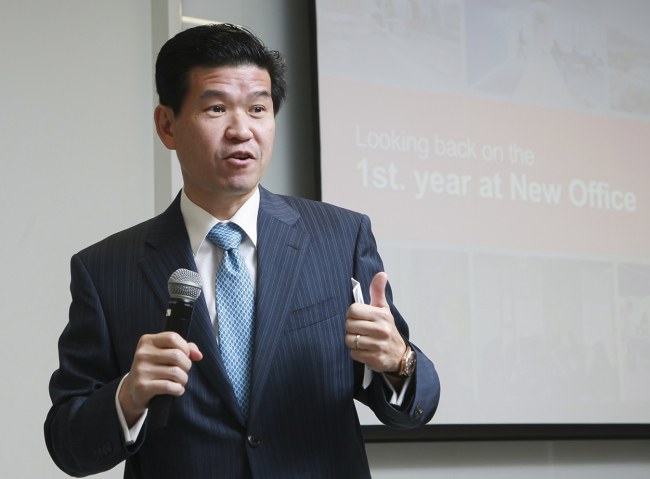Celebrating the anniversary of its move to a new head office in Gwanghwamun, central Seoul, on Thursday, Microsoft Korea introduced a range of positive changes achieved through its initiative to put mobile and cloud technology first at the workplace.
The company said this would become the new norm for other companies in the future.
The Korean branch of the software giant announced last year that it would transform its new Seoul headquarters into a ‘Freestyle Workplace,’ aimed at enhancing productivity and efficiency by providing a mobile phone and cloud-based work environment tailored to different tasks and work style of each employee.
“After adopting the system, which allows flexible working hours, Microsoft Korea has seen a significant improvement in teamwork and increased collaboration among employees,” said James Kim, chief executive of Microsoft Korea, at a news conference.
 |
| Microsoft Korea CEO James Kim speaks on the outcome achieved through the software firm’s initiative to build a digital workplace based on mobile and cloud technology in Seoul on Thursday. (Microsoft) |
“The Microsoft initiative to build the mobile workplace will be able to create a new IT ecosystem and become an exemplary model for other companies in Korea,” he added.
With the adoption of cloud-based office tools, thorough which employees can share schedules and files and work together on projects anytime and anywhere, time spent on daily collaboration increased from 2-3.5 to 3-4.5 hours, according to the company.
A survey conducted by the firm showed that around 90 percent of the employees are satisfied with the current working environment thanks to flexible working hours and remote working made possible via the mobile office devices and systems.
“Even a Microsoft employee who used to work for Samsung said the work environment is like a future office, with everything connected through mobile and cloud networks,” said Jung Woo-jin, enterprise strategy architect at Microsoft Korea’s consulting service team.
In keeping with the project aimed at improving work efficiency, the head office does not have any partition or wall, which fosters communication between different teams and individuals.
The firm has also got rid of designated seats for each employee, as is common in a typical office, but provides more space for meetings that workers can use any time without advance reservations.
After opening the office, which looks down at the Gyeongbokgung Palace dating back to the Joseon dynasty, last November, the company has received around 45,000 visitors, including executives of partner companies and government officials.
By Kim Young-won (wone0102@heraldcorp.com)



